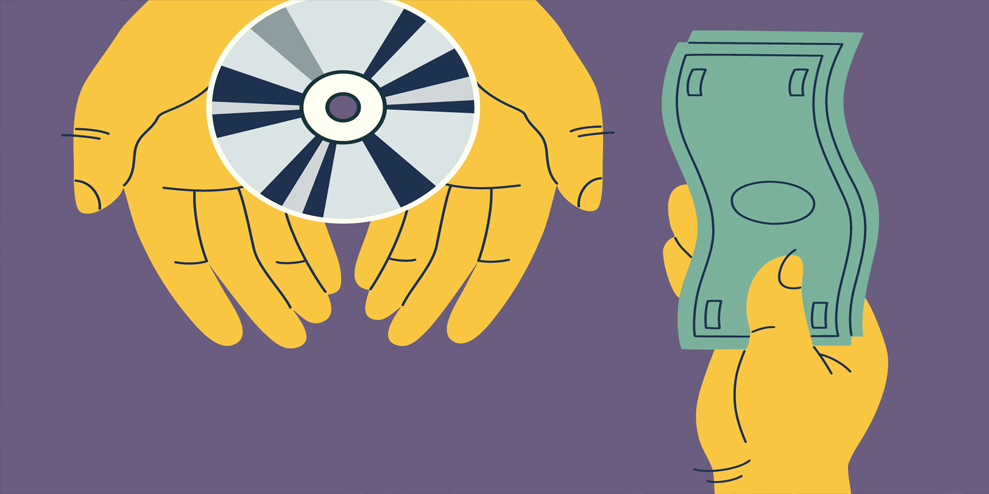People find digital music, books, and games more convenient — but think physical goods should cost more.
Between 2014 and 2018, global spending on DVDs and Blu-ray discs dropped nearly 50%, from $25 billion to $13 billion. Over the same period, spending on digital home entertainment grew by 160%.
And yet, even today, most Blu-rays cost more than the purchase of a digital movie.
“This is really irrational,” says Rhia Catapanoopen in new window, a former doctoral student at Stanford Graduate School of Business who’s now an assistant professor at the Rotman School of Management. “If we prefer a digital movie over a physical movie, then wouldn’t we spend more on it?”
Catapano explores this incongruity in a paper recently published in the Journal of Marketing Research. Together with Stanford GSB professor of marketing Jonathan Levav and Fuad Shennib, a Stanford GSB student who passed away in May 2020, she finds that people express an almost universal willingness to pay more for physical products. Yet simultaneously, they almost unanimously say they would prefer to own the digital version of the same product.
The researchers used 10 experiments to explore the extent of these “preference reversals.” In each case, one group of participants was asked the maximum price they would pay for a physical version and a digital version of a particular good; another group was asked which of the two they would like to own. The results showed that people are willing to pay more for physical goods but prefer digital goods not only when it comes to movies but also books, newspapers, video games, music, photographs, and even in-person versus online classes.
“More than any particular experiment, the sheer number of results is worth highlighting,” Catapano says. “We find this same shift in preferences across so many different categories.”
How Much for That Skimble?
This pattern held even when people were asked about a fictitious product called a “skimble.” Study participants were told that a skimble was estimated to cost between $5 and $100; they were told nothing about its manufacturer or its size, weight, or function. Nonetheless, 90% said they were willing to pay more for a physical skimble and 93% said they would prefer to own a digital skimble.QuoteYou strip everything else away and remove all associations, and people still think digital is more convenient and physical should cost more. It goes to show how deeply ingrained this idea is.AttributionRhia Catapano
“You strip everything else away and remove all associations, and people still think digital is more convenient and physical should cost more,” says Catapano. “It goes to show how deeply ingrained this idea is.”
These results rest on a psychological process known as contingent weighting: When people are asked how much they are willing to pay for something, they consider quantitative measures such as how much they are accustomed to paying for it; they relate this decision to what they know about prices in the market. When people are asked which product they would like to own, they consider qualitative measures and dwell on the products’ most important attributes. Because convenience often ranks highly and digital goods tend to be more convenient, people are inclined toward digital goods.
“On the face of it, people assume that the differentiation between digital and physical goods is vertical: One is heavy and the other light,” Levav says. “What we find is that this differentiation is horizontal, which is to say these products serve a fundamentally different set of needs. That may seem pretty straightforward, but behavioral research is often obvious in retrospect.”
Version Control
The results suggest that consumers trying to choose between digital and physical goods should take time to think carefully about what they want out of the purchase rather than being swayed toward one choice based on price. “We should think about what brings us value,” Catapano says. “We’re often hesitant to spend more on a digital good when, in fact, that is what we want.”
Meanwhile, Levav says, companies should rethink longstanding marketing practices that try to convince consumers that physical and digital goods are essentially identical. Rather, he says, companies should emphasize the specific traits that make digital goods valuable compared to their physical formats.
“We live in a world where we’re starting to see more and more interchangeability between physical and digital versions of goods,” Levav says. “We need to explore how these things are different in an essential way. Each one derives value from a totally different set of attributes. Companies that want to influence consumer perceptions of value need to know which attributes to focus on depending on what version of a product or experience they’re giving to people.”
This article first appeared in www.gsb.stanford.edu
Seeking to build and grow your brand using the force of consumer insight, strategic foresight, creative disruption and technology prowess? Talk to us at +971 50 6254340 or engage@groupisd.com or visit www.groupisd.com/story




